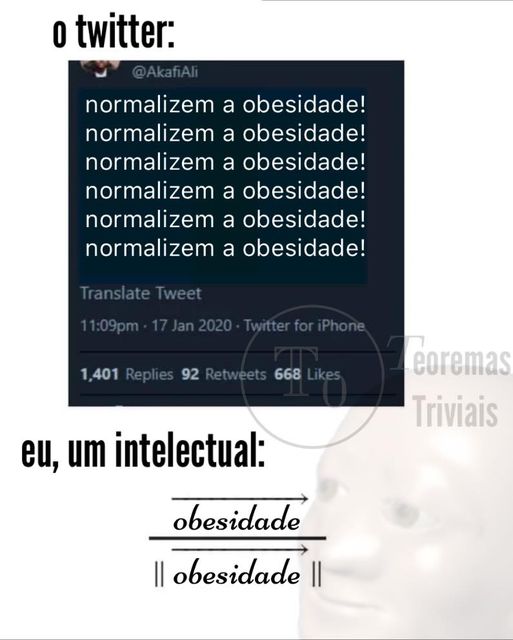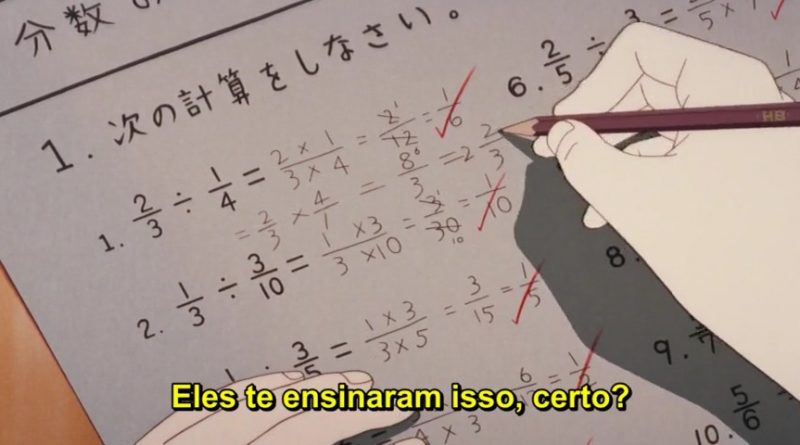Taeko Okajima’s Difficulty with Fraction Division: Part 2
In the previous post I narrated a little about the relationship of the character Taeko Okajima with the mathematics, from the 1991 anime Omoide Poro Poro (Only Yesterday) (you can access it by clicking here Taeko Okajima’s difficulty with fraction division: part 1). We’ll continue this discussion of Taeko’s doubt regarding the association of multiplying with increasing, and dividing with decreasing.
Multiply, according to the Michaelis Portuguese language dictionary, means:
- Repeat a number as many times as there are units of another;
- Perform the multiplication operation; do a multiplication;
- Increase the number of; present or produce in large quantities; swell, swell, grow;
- Grow in number; prolify, propagate;
- Increase in intensity; reduce, intensify, reiterate;
- Develop extraordinary activity; to unfold, to exceed;
- Produce beings or things of the same kind; increase, proliferate, prolify.
Of the 7 meanings pointed out by the dictionary, in 5 of them we have the idea that quantities are increasing.
To divide, according to the Portuguese language Michaelis dictionary, means:
- To separate (to be) (a whole) into parts, pieces, portions; to break (to break), to disunite (to disunite);
- Divide (something) and give a part, portion or piece to another; distribute, distribute;
- Distance things or people; separate, separate;
- Establish the boundaries of a terrain or any surface; demarcate, limit, shake;
- Arrange or organize (a whole) into its constituent parts (sections, classes, distinct groups, chapters, etc.); segment;
- Separate different elements, in order to organize them by any criterion; classify, catalog;
- Participate in something together with others, sharing with others; share, share;
- Crossing, crossing (any surface), establishing a separating crease; furrow;
- Perform a division (arithmetic operation);
- Establish(se) discord between, provoke disagreements; disagree(s), disagree(s);
- Disperse efforts, causing damage to a work or a collective cause;
- Kicking (the ball) at the same time as the opponent; play (a ball);
- Decompose a morphic or syntactic structure into its minimal units, in order to isolate and/or identify the elements that compose it.
Of the 13 meanings pointed out by the dictionary, in 12 of them we have the idea that parts are separated, having an even broader meaning than the word Multiply.
In this relation of meanings, it is rather imprudent to say that “Multiply” is the opposite of “Divide”.
Thus, in the anime Omoide Poro Poro (Only Yesterday), the character Takeo presented the idea that Multiplying is about increasing quantities, while Dividing is about decreasing quantities. Questioning your sister Yaeko about how it was possible to divide 2/3 of an apple by 1/4, and thus get more than the apple itself?
The character’s doubt is really centered on the fact that we share the words of Mathematics with those of the common language. As in the meme below that plays with the expression normalize with the sense of normalize in mathematics which means “pass the norm”:

Jokes aside, when we focus on the meaning of some words in Mathematics that also exist in common language, it is natural that their meanings need to be “well defined”, otherwise we make room for the subjectivity of the language.
Thus, the role of a definition is to describe a certain mathematical object unequivocally within the set to which it belongs. For example, I can describe multiplication. between the Natural numbers X and Y as:
X.Y is the operation that adds to 0 the number X by Y times.
Similarly, the multiplication * between Integers A and B can be defined as (let’s use the sign . to say that this is the multiplication defined for the Natural numbers):
if A > 0 and B > 0, AB will be the operation of A.B;
if A < 0 and B < 0, AB will be the operation does (-A).(-B);
if A > 0 and B < 0, AB is the operation that subtracts the number A from 0 by -B times;
if A < 0 and B > 0, AB is the operation that subtracts from 0 the number -A by B times;
if A = 0 or B = 0, A*B will be 0.
See how much more complicated it was to define the multiplication now that we have positive and negative values involved, in this case, we could take advantage of the definition of the multiplication of the Natural numbers. at the time of performing these operations. Note that the advantage of this more complicated definition is that it does not allow room for subjectivity or ambiguous interpretations.
Now let’s define the # multiplication between Rational numbers written as C/D and E/F where C, D, E and F are Integers, and D and F are different from 0 (let’s use * to say it’s the multiplication defined for Integer numbers).
(C/D)#(E/F) will be the operation that does (C*E)/(D*F).
Thus, when we have a multiplication of Rational numbers denoted in this text as #, we are referring to its mathematical definition presented, and not its meaning in common language. The same is true for the division of Rational numbers, which we will denote with the symbol [].
if E is different from 0, (C/D) is the operation that does (C*F)/(D*E).
Note that although when we talk about Rational numbers, we are representing them with the sign of division / applied to the integers C, D, E and F. However, when we are talking about division of Rational numbers, we are representing it with the sign [ ], which refers to the operation as we define it, which uses only the Integer multiplication definition.
In fact, the multiplicity of meanings in the common language can be a confusing factor when expressing ourselves, demanding that the word be interpreted within its context and intentions of the one who uses it for the one who receives it. Precisely to avoid an ambiguous interpretation, which is so common in mathematics, we start with definitions. Making it clear to those who read how each “object” we are naming works.
Let’s stop here, but the discussion continues in the next post: Taeko Okajima’s difficulty with fraction division: part 3
Cover image taken from the anime Omoide Poro Poro (Only Yesterday).

